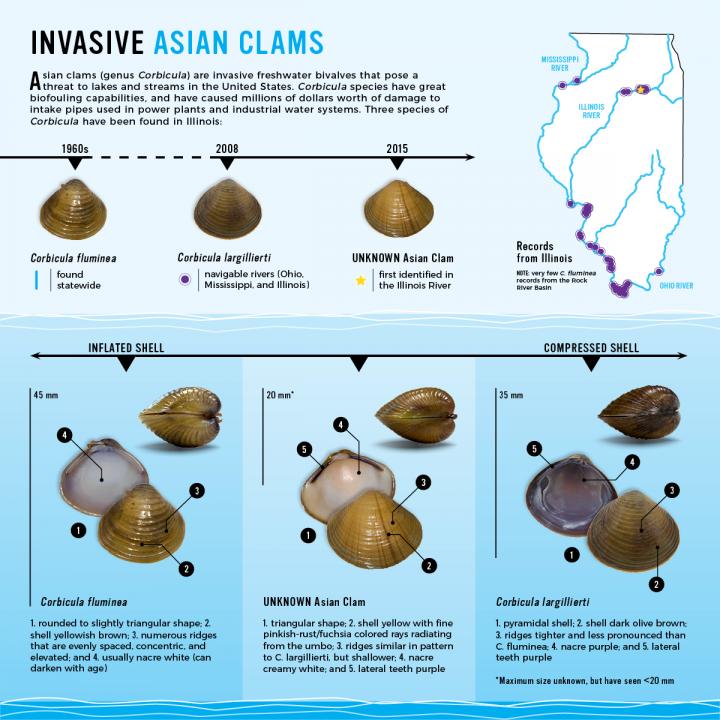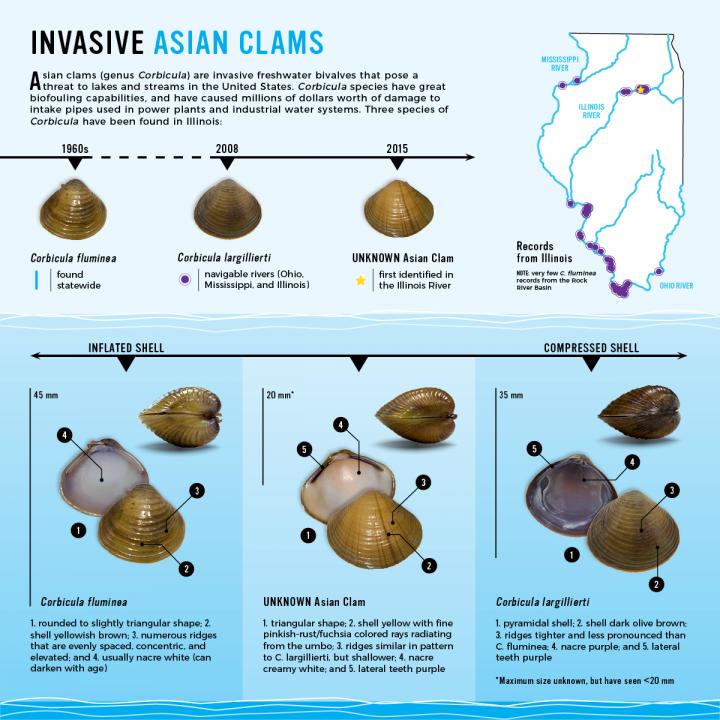
Credit: Graphic by Danielle Ruffatto
CHAMPAIGN, Ill. — They found it in the Illinois River near the city of Marseilles, Illinois, about 80 miles west of Lake Michigan – a strange entry point for an invasive Asian clam. The scientists who found it have no idea how it got there. But the discovery – along with genetic tests that confirm its uniqueness – means that a new species or "form" of invasive clam has made its official debut in North America.
The researchers report the find in the journal BioInvasions Records.
This is only the latest invasive aquatic species to settle in North America, said Illinois Natural History Survey aquatic ecologist Jeremy Tiemann, who discovered the new clam with INHS mussel field biologist Sarah Douglass in late 2015. The INHS is a division of the Prairie Research Institute at the University of Illinois.
"In the Midwest, you have invasive bivalves, including zebra mussels, and several species of invasive fish: Asian carp, black carp and even goldfish," Tiemann said. There are exotic plants, like Eurasian milfoil. There is an invasive water flea from Africa, Asia and Australia. There also are several kinds of invasive snails, the researchers said. All of these create problems for the natives.
The new invader is a member of the genus Corbicula, which was first observed in Vancouver, British Columbia, in 1924. It likely was brought to North America by immigrants from Asia who used the clams as food, the researchers said. Within a few decades, it had colonized many of the major waterways of North America. (See animated map).
Douglass and Tiemann found the new clams while hunting through a mudflat for a federally endangered native clam, the scaleshell, that had been spotted in the same location two years before. They noticed that this tiny creature, roughly the size of a fingernail, had unusual physical characteristics compared with the other invasive species of Corbicula found in this region.
The Illinois team shared the find with researchers at the University of Michigan, who conducted genetic tests that confirmed the new clams were distinct from earlier Corbicula invaders.
Despite the genetic and physical differences, the researchers can't say whether the clam is a new species. Corbicula have reproductive strategies that make them difficult to classify, the researchers said. To begin with, they are androgenic clones.
"When the sperm fertilizes the egg, it kicks out the maternal nuclear DNA, retaining only the male's, and thus producing clones of the father," Tiemann said. "These offspring, however, retain the mother's mitochondrial DNA, which resides in tiny organelles outside the nucleus."
Corbicula also can hybridize with other Corbicula taxa, further complicating the task of classifying them, Tiemann said.
"To compound matters even more, Corbicula can also be hermaphrodites, so they can fertilize themselves," he said. "This means that it takes only a single clam to spawn a new population."
To help distinguish among species, researchers can examine the nuclear or mitochondrial DNA, Tiemann said.
"With Corbicula, the nuclear DNA tells one story, but the mitochondrial DNA can suggest something different," he said. "As a result, we use the word 'form' to distinguish different taxa within a group, as is the case with Corbicula."
No matter how it is classified, the new invader is likely not good news for native clams or the river ecosystem as a whole, the researchers said.
"Corbicula consume the same resources as the natives," Tiemann said.
"It's thought that they also can consume the larvae of the natives, although that hasn't been proved," Douglass said.
Invaders often have no natural enemies in a new locale, and tend to overpopulate, driving out the natives and sometimes overextending themselves, she said.
So far, the ultimate consequences of the latest exotic to take up residence in U.S. waters remains to be seen, the researchers said.
"But if past invasions are any indication, it may signal further erosion of ecosystem services traditionally provided by watersheds already impacted by Corbicula," Tiemann said.
###
Editor's notes:
To reach Sarah Douglass, call 217-300-4018; email [email protected].
To reach Jeremy Tiemann, call 217-244-4594; email [email protected].
The paper "First record of a putative novel invasive Corbicula lineage discovered in the Illinois River, Illinois, USA" is available online and from the U. of I. News Bureau.
DOI: https://doi.org/10.3391/bir.2017.6.2.12
Media Contact
Diana Yates
[email protected]
217-333-5802
@NewsAtIllinois
http://www.illinois.edu
############
Story Source: Materials provided by Scienmag





